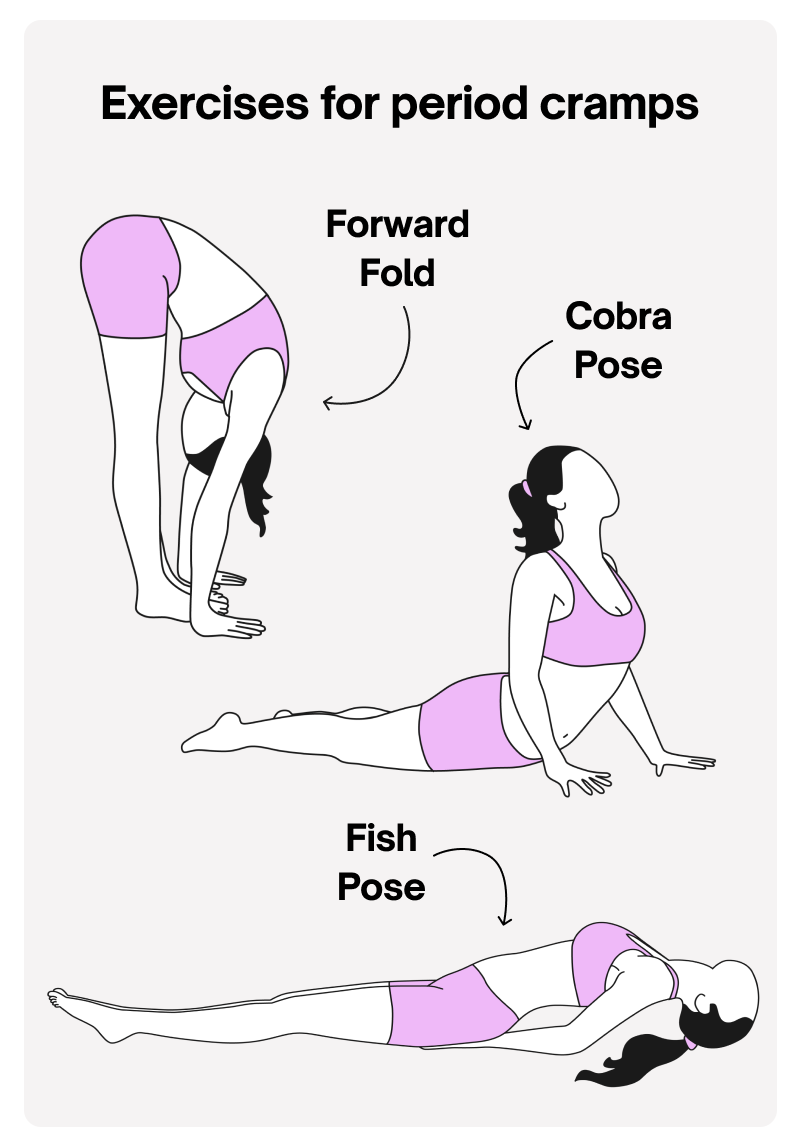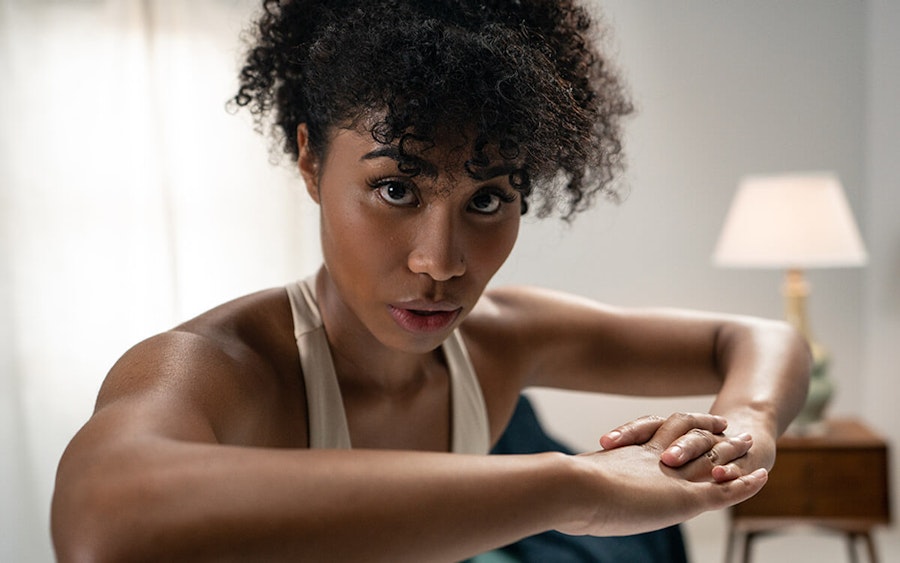Exercise for period cramps: Tips & stretches for pain relief
Follows NC° Editorial Policy
At Natural Cycles, our mission is to empower you with the knowledge you need to take charge of your health. At Cycle Matters, we create fact-checked, expert-written content that tackles these topics in a compassionate and accessible way. Read more...
Key takeaways:
- Gentle movement on your period can help relieve pain and may also boost your mood
- Consider trying low-impact exercises like yoga, swimming or walking
Luckily, that doesn’t mean you need to go hard in the gym or hit the pavement for a half marathon. If that’s what you’re into, then by all means – go ahead and enjoy your session! But it’s also perfectly fine to take it easier during your period: whatever works for you to alleviate your period symptoms.
What causes period cramps?
Not everyone gets period cramps. But those who do will know just how painful they can be. Period pain usually comes on just before or during your period, and it can cause various symptoms, including [3]:
- Cramps in your tummy, back and/or thighs
- Sharp pains or dull aches in your tummy
- Feeling tired
- Feeling bloated
- Diarrhea
- Headaches
- Mood changes
But what causes period pain? During your period, your uterus sheds its lining, and contracts to help expel it as menstrual blood. Hormone-like substances called prostaglandins are responsible for making your uterus tighten and relax, and too many prostaglandins can have some side effects, including period poop and period pain [4]. This is the most common cause of menstrual cramps, but they can also be caused by other conditions, such as [5]:
- Endometriosis and adenomyosis, which cause womb tissue to grow in other parts of the body
- Fibroids, which are growths in and around the womb
- Pelvic inflammatory disease (PID), an infection of the female reproductive system
- An intrauterine device (IUD), especially in the first three to six months after insertion
If you’re concerned about your period cramps, or if they seem worse than usual, contact your doctor for advice.
Benefits of exercise during your period
There isn’t a huge amount of research into this area, but some studies have found that exercise can reduce period cramps, with active study participants reporting less pain than sedentary participants during their period [2,6].
It’s thought that this is down to the fact that exercise triggers the release of endorphins. These are natural painkillers that can reduce menstrual cramps and discomfort [7].
Additionally, exercise can help improve other PMS symptoms, like fatigue, low mood and anxiety [8]. Regular exercise is great for both your body and mind at all times, not just during your period. But if a gentle walk or some stretching can help to reduce your period pain and boost your mood, then it’s all the more reason to pull on your sneakers.
Exercises for painful period cramps
So, if you do want to see if exercise can help relieve your pain, here are some tried-and-tested workouts.
Pelvic stretches for painful period cramps
Let’s start with some stretches that you can do anywhere, whether at home, in the yoga studio, or at the gym. Yoga for period cramps can be a great way of stretching out areas you might find painful during your period – and it also offers huge mental benefits. Yoga can help you to reduce stress and anxiety and enable you to become more mindful, all of which may also help you to better deal with period pain.

Fish pose
The move: Start by lying on your back with your legs extended and your arms resting alongside your body. Slide your hands, palms down, underneath your buttocks. Press your forearms and elbows firmly into the ground, then lift your upper body and arch your back, tilting your head back to rest the crown on the floor or a pillow. Hold the pose for several breaths, then release by carefully lowering your head and torso back down, and relaxing your arms by your side.
The benefit: Fish pose helps to stretch the front of the body, including the pelvic area, and may improve blood flow.
Cobra pose
The move: Start by lying face down, and place your palms flat beside your shoulders. Keeping your elbows close to your body, slowly begin to straighten your arms, lifting your chest off the mat. Keep your elbows slightly bent and your shoulders away from your ears. Arch your back gently, and keep your pubic bone connected to the ground or your yoga mat. Hold the pose for a few breaths, then release by exhaling and slowly lowering your chest and forehead back down onto the mat.
The benefit: It strengthens the spine and improves flexibility in the back muscles, which can help to reduce tension and discomfort. This pose also opens up the chest and lungs and helps to promote deep breathing, which can have a calming effect on the body.
Forward fold
The move: Start by standing with your feet hip-width apart. Inhale deeply, lengthen your spine, and then exhale as you hinge at your hips and fold forward from your waist. Place your hands on the floor or a yoga block, hold your shins or ankles or grab onto opposite elbows. If your hamstrings are tight, keep a slight bend in your knees. Relax your head and neck, letting them hang naturally. Hold the pose for a few breaths, then release by bending your knees and slowly rolling up to standing, one vertebrae at a time.
The benefit: The humble forward fold targets your lower back, one of the areas where many people feel period cramps. It can gently release the lower back, while stretching out a stiff neck and shoulders.
Aerobic exercises for period pain
Yoga and stretching are great for reducing pain and helping you to relax – but high-intensity exercise can also reduce the intensity of period pain, compared with not exercising[9]. Some aerobic exercises to try include:
Swimming
The low-impact movement and stretching of muscles while swimming during your period can also help release tension and improve mood, which may further alleviate menstrual discomfort. Just remember to listen to your body, and choose whichever stroke – and whatever intensity level – feels best for you during your period.
Walking
Walking is generally low-impact and gentle on the joints, making it suitable for most people, even during menstruation when you might feel more sensitive or fatigued. Plus, like any form of exercise, walking stimulates the release of endorphins, which can help to reduce menstrual cramps and improve your mood.
Cycling
As with other types of aerobic exercise, cycling will dish out those feel-good endorphins, which can boost your mood and may help to alleviate symptoms of PMS – and may also help to reduce period cramps. And you don’t need to restrict it to a gentle cycle in your local park. One study found that a 10-week trial of high-intensity interval training using a spinning bike could improve premenstrual symptoms, menstrual distress, and menstrual pain severity[10].
Other methods for period pain relief
And if you don’t feel up to exercising? That’s fine too. There are other ways you can reduce period pain[11]. Some other things to try include:
- Heat therapy: Try applying a heat pad, warm towel, or hot water bottle to your tummy or lower back to relax your muscles and reduce cramps.
- Take a warm bath or shower
- Massage: Gentle abdominal or lower back massage can improve blood circulation and provide relief from cramping. You can either do this yourself, ask a partner or friend, or pay a professional – what better excuse to treat yourself?
- Stay hydrated: Drinking plenty of water can help to reduce the severity of period pain, and reduce the amount of pain medication people need to take.
- Take medication:: That being said, Tylenol or Advil can help relieve pain.
Tracking ovulation and irregular cycles
Understanding your own menstrual cycle is a great first step to getting to know your body better. As well as using Natural Cycles to either plan or prevent pregnancy, you can also record cycle symptoms (such as period pain) in the app, this can help you spot patterns in your unique cycle and manage symptoms accordingly. Why not find out if Natural Cycles could work for you today?
Did you enjoy reading this article?
